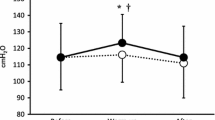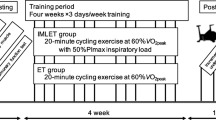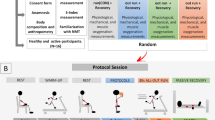Abstract
The effects of inspiratory muscle (IM) warm-up on the maximum dynamic IM function and the maximum repetitions of 20-m shuttle run (Ex) in the Yo-Yo intermittent recovery test were examined. Ten men were recruited to perform identical IM function test and exercise test in three different trials randomly. The control trial was without IM warm-up while the placebo and experimental trials were with IM warm-up by performing two sets of 30 breaths with inspiratory pressure-threshold load equivalent to 15% (IMWP) and 40% (IMW) maximum inspiratory mouth pressure, respectively. In IMW, maximum dynamic IM functions including the maximal inspiratory pressure at zero flow (P 0) and maximal rate of P 0 development (MRPD) were increased compared with control values (P<0.05). The Ex was also augmented [mean (SD)] [19.5% (12.6)] while the slope of the linear relationship of the increase in rating of perceived breathlessness for every 4th exercise interval (RPB/4i) was reduced (P<0.05). In IMWP, although increase in Ex and reduction in RPB/4i were occurred concomitantly in some subjects, the differences in Ex, RPB/4i and dynamic IM functions between control and IMWP trials were not statistically significant. For the changes (Δ) in parameters in IMW and IMWP (n=20), negative correlations were found between Δ RPB/4i and Δ Ex (r=−0.92), ΔP 0 and Δ RPB/4i (r=−0.48), and Δ MRPD and Δ RPB/4i (r=−0.54). Such findings suggested that the specific IM warm-up in IMW may entail reduction in breathlessness sensation, partly attributable to the enhancement of dynamic IM functions, in subsequent exhaustive intermittent run and, in turn, improve the exercise tolerance.



Similar content being viewed by others
References
Binkhorst RA, Hoofd L, Vissers AC (1977) Temperature and force–velocity relationship of human muscles. J Appl Physiol 42:471–475
Bishop D (2003) Warm up I: potential mechanisms and the effects of passive warm up on exercise performance. Sports Med 33:439–454
Boussana A, Galy O, Hue O, Matecki S, Varray A, Ramonatxo M, Le Gallais D (2003) The effects of prior cycling and a successive run on respiratory muscle performance in triathletes. Int J Sports Med 24:63–70
Burnley M, Doust JH, Jones AM (2005) Effects of prior warm-up regime on severe-intensity cycling performance. Med Sci Sports Exerc 37:838–845
Davies CT, Young K (1983) Effect of temperature on the contractile properties and muscle power of triceps surae in humans. J Appl Physiol 55:191–195
Johnson BD, Babcock MA, Suman OE, Dempsey JA (1993) Exercise-induced diaphragmatic fatigue in healthy humans. J Physiol 460:385–405
Krustrup P, Mohr M, Amstrup T, Rysgaard T, Johansen J, Steensberg A, Pedersen PK, Bangsbo J (2003) The yo-yo intermittent recovery test: physiological response, reliability, and validity. Med Sci Sports Exerc 35:697–705
MacIntosh BR, Bryan SN (2002) Potentiation of shortening and velocity of shortening during repeated isotonic tetanic contractions in mammalian skeletal muscle. Pflugers Arch 443:804–812
Ranatunga KW, Sharpe B, Turnbull B (1987) Contractions of a human skeletal muscle at different temperatures. J Physiol 390:383–395
Redline S, Gottfried SB, Altose MD (1991) Effects of changes in inspiratory muscle strength on the sensation of respiratory force. J Appl Physiol 70:240–245
Romer LM, McConnell AK (2003) Specificity and reversibility of inspiratory muscle training. Med Sci Sports Exerc 35:237–244
Romer LM, McConnell AK, Jones DA (2002a) Effects of inspiratory muscle training on time-trial performance in trained cyclists. J Sports Sci 20:547–562
Romer LM, McConnell AK, Jones DA (2002b) Effects of inspiratory muscle training upon recovery time during high intensity, repetitive sprint activity. Int J Sports Med 23:353–360
Sale DG (2002) Postactivation potentiation: role in human performance. Exerc Sport Sci Rev 30:138–143
Sale DG (2004) Postactivation potentiation: role in performance. Br J Sports Med 38:386–387
Steinacker JM, Both M, Whipp BJ (1993) Pulmonary mechanics and entrainment of respiration and stroke rate during rowing. Int J Sports Med 14(Suppl. 1):S15–S19
Tong TK, Fu FH, Chow BC (2001a) Effect of nasal dilatation on prolonged all-out intermittent exercise performance. J Sports Med Phys Fitness 41:189–195
Tong TK, Fu FH, Chow BC (2001b) Nostril dilatation increases capacity to sustain moderate exercise under nasal breathing condition. J Sports Med Phys Fitness 41:470–478
Tong TK, Fu FH, Chow BC, Quach B, Lu K (2003a) Increased sensations of intensity of breathlessness impairs maintenance of intense intermittent exercise. Eur J Appl Physiol 88:370–379
Tong TK, Quach B, Lu K (2003b) The control of normal inspiratory muscle force output restricts the rise of ventilation during intense intermittent exercise. J Exerc Sci Fitness 1:33–40
Tong TK, Fu FH, Quach B, Lu K (2004) Reduced sensations of intensity of breathlessness enhances maintenance of intense intermittent exercise. Eur J Appl Physiol 92:275–284
Volianitis S, McConnell AK, Koutedakis Y, Jones DA (1999) The influence of prior activity upon inspiratory muscle strength in rowers and non-rowers. Int J Sports Med 20:542–547
Volianitis S, McConnell AK, Jones DA (2001a) Assessment of maximum inspiratory pressure. Prior submaximal respiratory muscle activity (‘warm-up’) enhances maximum inspiratory activity and attenuates the learning effect of repeated measurement. Respiration 68:22–27
Volianitis S, McConnell AK, Koutedakis Y, Jones DA (2001b) Specific respiratory warm-up improves rowing performance and exertional dyspnea. Med Sci Sports Exerc 33(7):1189–1193
Wilson RC, Jones PW (1990) Influence of prior ventilatory experience on the estimation of breathlessness during exercise. Clin Sci (Lond) 78:149–153
Acknowledgements
Our sincere thanks are extended to Binh Quach, Ellen K. Lu, Jin Lei Nie and Chuan Ye Huang for their valuable contributions to this project.
Author information
Authors and Affiliations
Corresponding author
Rights and permissions
About this article
Cite this article
Tong, T.K., Fu, F.H. Effect of specific inspiratory muscle warm-up on intense intermittent run to exhaustion. Eur J Appl Physiol 97, 673–680 (2006). https://doi.org/10.1007/s00421-006-0233-6
Accepted:
Published:
Issue Date:
DOI: https://doi.org/10.1007/s00421-006-0233-6




